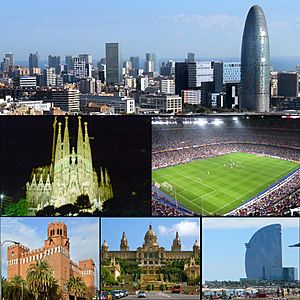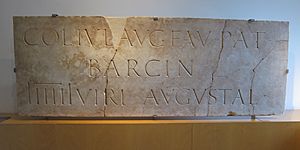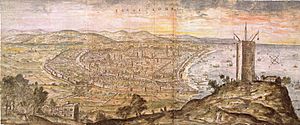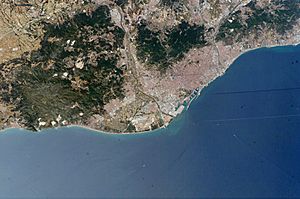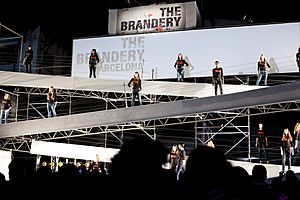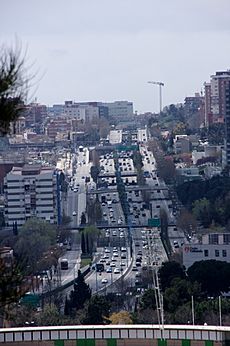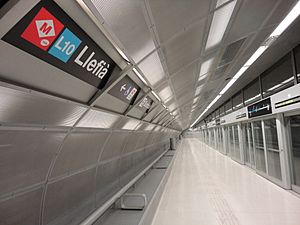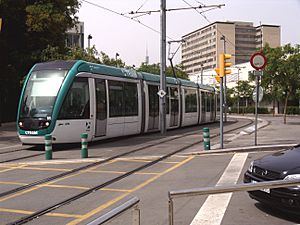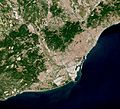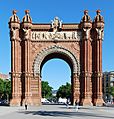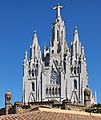Barcelona facts for kids
Barcelona is a city in Spain. It is the capital city of Catalonia, which is a region of Spain. Barcelona is the largest city on the Mediterranean coast. The city is between the rivers of Llobregat and Besòs, and south of the Pyrenees mountains. It has a hot-summer Mediterranean climate (Csa in the Koeppen climate classification).
In 1992, Barcelona hosted the Summer Olympic Games. It was a great opportunity to improve the city. Many new parks were opened and other significant changes to the city were made. One example is opening the new beaches in the Poble Nou area.
In 2007, about 1.6 million people lived in Barcelona. Around 3.1 million people live in the Metropolitan Area and 4.9 million people live in the Urban Region. Barcelona is the second most populated city in Spain, and the tenth in the European Union.
Barcelona is one of the most important tourist destinations in Europe, with millions of people visiting every year. The city is famous for its 19th century modernist architecture. The best known of those buildings was designed by Antonio Gaudi. It is the unfinished church Sagrada Familia, which is the symbol of Barcelona.
It is known for its tapas food, a delicious meze.
Barcelona is home to one of the most popular and greatest football teams in the world,which is F.C. Barcelona.
Contents
History
The origin of the earliest settlement at the site of present-day Barcelona is unclear. The ruins of an early settlement have been excavated in the El Raval neighbourhood, including different tombs and dwellings dating to earlier than 5000 BC. The founding of Barcelona is the subject of two different legends. The first attributes the founding of the city to the mythological Hercules. The second legend attributes the foundation of the city directly to the historical Carthaginian general, Hamilcar Barca, father of Hannibal, who supposedly named the city Barcino after his family in the 3rd century BC, but there is no historical or linguistic evidence that this is true.
In about 15 BC, the Romans redrew the town as a castrum (Roman military camp) centred on the "Mons Taber", a little hill near the contemporary city hall (Plaça de Sant Jaume). Under the Romans, it was a colony with the surname of Faventia, or, in full, Colonia Faventia Julia Augusta Pia Barcino or Colonia Julia Augusta Faventia Paterna Barcino. Pomponius Mela mentions it among the small towns of the district, probably as it was eclipsed by its neighbour Tarraco (modern Tarragona), but it may be gathered from later writers that it gradually grew in wealth and consequence, favoured as it was with a beautiful situation and an excellent harbour. It enjoyed immunity from imperial burdens. The city minted its own coins; some from the era of Galba survive.
Important Roman vestiges are displayed in Plaça del Rei underground, as a part of the Barcelona City History Museum MUHBA; the typically Roman grid plan is still visible today in the layout of the historical centre, the Barri Gòtic (Gothic Quarter). Some remaining fragments of the Roman walls have been incorporated into the cathedral. The cathedral, also known as the Basilica La Seu, is said to have been founded in 343. The city was conquered by the Visigoths in the early 5th century, becoming for a few years the capital of all Hispania. After being conquered by the Arabs in the early 8th century, it was conquered in 801 by Charlemagne's son Louis, who made Barcelona the seat of the Carolingian "Hispanic March" (Marca Hispanica), a buffer zone ruled by the Count of Barcelona.
The Counts of Barcelona became increasingly independent and expanded their territory to include all of Catalonia, although on 6 July 985, Barcelona was sacked by the army of Almanzor. The sack was so traumatic that most of Barcelona's population was either killed or enslaved. In 1137, Aragon and the County of Barcelona merged in dynastic union by the marriage of Ramon Berenguer IV and Petronilla of Aragon, their titles finally borne by only one person when their son Alfonso II of Aragon ascended to the throne in 1162. His territories were later to be known as the Crown of Aragon, which conquered many overseas possessions and ruled the western Mediterranean Sea with outlying territories in Naples and Sicily and as far as Athens in the 13th century. The forging of a dynastic link between the Crowns of Aragon and Castile marked the beginning of Barcelona's decline. The Bank of Barcelona (Taula de canvi), probably the oldest public bank in Europe, was established by the city magistrates in 1401. It originated from necessities of the state, as did the Bank of Venice (1402) and the Bank of Genoa (1407).
The marriage of Ferdinand II of Aragon and Isabella I of Castile in 1469 united the two royal lines. Madrid became the centre of political power whilst the colonisation of the Americas reduced the financial importance (at least in relative terms) of Mediterranean trade. Barcelona was a centre of Catalan separatism, including the Catalan Revolt (1640–52) against Philip IV of Spain. The great plague of 1650–1654 halved the city's population.
In the 18th century, a fortress was built at Montjuïc that overlooked the harbour. In 1794, this fortress was used by the French astronomer Pierre François André Méchain for observations relating to a survey stretching to Dunkirk that provided the official basis of the measurement of a metre. The definitive metre bar, manufactured from platinum, was presented to the French legislative assembly on 22 June 1799. Much of Barcelona was negatively affected by the Napoleonic wars, but the start of industrialisation saw the fortunes of the province improve. Urban planner Ildefons Cerdà designed the large Eixample district in the 1850s when the medieval city walls around Barcelona's old town were torn down.
During the Spanish Civil War, the city, and Catalonia in general, were resolutely Republican. Many enterprises and public services were "collectivized" by the CNT and UGT unions. As the power of the Republican government and the Generalitat diminished, much of the city was under the effective control of anarchist groups. The anarchists lost control of the city to their own allies, the Communists and official government troops, after the street fighting of the Barcelona May Days. The fall of the city on 26 January 1939, caused a mass exodus of civilians who fled to the French border. The resistance of Barcelona to Franco's coup d'état was to have lasting effects after the defeat of the Republican government. The autonomous institutions of Catalonia were abolished, and the use of the Catalan language in public life was suppressed. Barcelona remained the second largest city in Spain, at the heart of a region which was relatively industrialised and prosperous, despite the devastation of the civil war. The result was a large-scale immigration from poorer regions of Spain (particularly Andalusia, Murcia and Galicia), which in turn led to rapid urbanisation. The city gained vitality in 1992 when it hosted the Summer Olympics.
Geography
Location
Barcelona is located on the northeast coast of the Iberian Peninsula, facing the Mediterranean Sea, on a plain approximately 5 km (3 mi) wide limited by the mountain range of Collserola, the Llobregat river to the southwest and the Besòs river to the north. This plain covers an area of 170 km2 (66 sq mi), of which 101 km2 (39.0 sq mi) are occupied by the city itself. It is 120 kilometres (75 miles) south of the Pyrenees and the Catalan border with France.
The city borders on the municipalities of Santa Coloma de Gramenet and Sant Adrià de Besòs to the north; the Mediterranean Sea to the east; El Prat de Llobregat and L'Hospitalet de Llobregat to the south; and Sant Feliu de Llobregat, Sant Just Desvern, Esplugues de Llobregat, Sant Cugat del Vallès, and Montcada i Reixac to the west. The municipality includes two small sparsely-inhabited exclaves to the north-west.
Climate
Barcelona has a humid subtropical climate (Köppen Cfa) bordering a maritime Mediterranean climate (Csa), with mildly cool winters and hot, muggy summers, while the rainiest seasons are autumn and spring.
Main sights
The Barri Gòtic (Catalan for "Gothic Quarter") is the centre of the old city of Barcelona. Many of the buildings date from medieval times, some from as far back as the Roman settlement of Barcelona. Catalan modernista architecture (related to the movement known as Art Nouveau in the rest of Europe) developed between 1885 and 1950 and left an important legacy in Barcelona. Several of these buildings are World Heritage Sites.
Barcelona was also home to Mies van der Rohe's Barcelona Pavilion. Designed in 1929 for the International Exposition for Germany, it was an iconic building that came to symbolise modern architecture as the embodiment of van der Rohe's aphorisms "less is more" and "God is in the details." The Barcelona pavilion was intended as a temporary structure and was torn down in 1930 less than a year after it was constructed. A modern re-creation by Spanish architects now stands in Barcelona, however, constructed in 1986.
Barcelona won the 1999 RIBA Royal Gold Medal for its architecture, the first (and as of 2015[update], only) time that the winner has been a city rather than an individual architect.
Parks
Barcelona contains sixty municipal parks, twelve of which are historic, five of which are thematic (botanical), forty-five of which are urban, and six of which are forest. They range from vest-pocket parks to large recreation areas. The urban parks alone cover 10% of the city (549.7 ha or 1,358.3 acres). The total park surface grows about 10 ha (25 acres) per year, with a proportion of 18.1 square metres (195 sq ft) of park area per inhabitant.
Beaches
Barcelona beach was listed as number one in a list of the top ten city beaches in the world according to National Geographic and Discovery Channel. Barcelona contains seven beaches, totalling 4.5 kilometres (2.8 miles) of coastline. Sant Sebastià, Barceloneta and Somorrostro beaches, both 1,100 m (3,610 ft) in length, are the largest, oldest and the most-frequented beaches in Barcelona.
Demographics
According to Barcelona's City Council, Barcelona's population as of 1 January 2016 was 1,608,746 people, on a land area of 101.4 km2 (39 sq mi).
Spanish is the most spoken language in Barcelona (according to the linguistic census held by the Government of Catalonia in 2013) and it is understood almost universally. After Spanish, Catalan language is the second most spoken one in the city, and it is understood by 95% of the population, while 72.3% can speak it, 79% can read it, and 53% can write it, thanks to the language immersion educational system.
Population density
Barcelona is one of the most densely populated cities in Europe.
Of the 73 neighbourhoods in the city, 45 had a population density above 20,000 inhabitants per square kilometre with a combined population of 1,313,424 inhabitants living on 38.6 km2 at an average density of 33,987 inhabitants per square km.
Migration
Quick facts for kids Largest groups of foreign residents in Barcelona |
|
| Nationality | Population (2016) |
|---|---|
| 26,676 | |
| 19,160 | |
| 18,434 | |
| 13,506 | |
| 12,537 | |
| 9,291 | |
| 8,682 | |
| 8,109 | |
| 7,944 | |
| 7,904 | |
In 2016 about 59% of the inhabitants of the city were born in Catalonia and 18.5% coming from the rest of the country. In addition to that, 22.5% of the population was born outside of Spain, a proportion which has more than doubled since 2001 and more than quintupled cince 1996 when it was 8.6% respectively 3.9%.
The most important region of origin of migrants is Europe, with many coming from Italy (26,676) or France (13,506). Moreover many migrants come from Latin American nations as Bolivia, Ecuador or Colombia. Since the 1990s, and similar to other migrants, many Latinos have settled in northern parts of the city.
There exists a relatively large Pakistani community in Barcelona with up to twenty thousand nationals. The community consists of significantly more men than women. Many of the Pakistanis are living in Ciutat Vella. First Pakistani migrants came in the 1970s, with increasing numbers in the 1990s.
Other significant migrant groups come from Asia as from China and the Philippines. There is a Japanese community clustered in Bonanova, Les Tres Torres, Pedralbes, and other northern neighbourhoods, and a Japanese international school serves that community.
Religion
Most of the inhabitants state they are Roman Catholic (208 churches). In a 2011 survey conducted by InfoCatólica, 49.5% of Barcelona residents of all ages identified themselves as Catholic. This was the first time that more than half of respondents did not identify themselves as Catholic. The numbers reflect a broader trend in Spain whereby the numbers of self-identified Catholics have declined.
The province has the largest Muslim community in Spain, 322,698 people in Barcelona province are of Muslim faith. A considerable number of Muslims live in Barcelona due to immigration (169 locations, mostly professed by Moroccans in Spain). In 2014, 322,698 out of 5.5 million people in the province of Barcelona identified themselves as Muslim, which makes 5.6% of total population.
The city also has the largest Jewish community in Spain, with an estimated 3,500 Jews living in the city. There are also a number of other groups, including Evangelical (71 locations, mostly professed by Roma), Jehovah's Witnesses (21 Kingdom Halls), Buddhists (13 locations), and Eastern Orthodox.
Economy
General information
Barcelona was the 14th most "livable city" in the world in 2009 according to lifestyle magazine Monocle.
Barcelona has a long-standing mercantile tradition. Less well known is that the city industrialised early, taking off in 1833, when Catalonia's already sophisticated textile industry began to use steam power. It became the first and most important industrial city in the Mediterranean basin. Since then, manufacturing has played a large role in its history.
Tourism
Barcelona was the 20th-most-visited city in the world by international visitors and the fifth most visited city in Europe after London, Paris, Istanbul and Rome, with 5.5 million international visitors in 2011. By 2015, both Prague and Milan had more international visitors. With its Rambles, Barcelona is ranked the most popular city to visit in Spain.
Barcelona as internationally renowned a tourist destination, with numerous recreational areas, one of the best beaches in the world, mild and warm climate, historical monuments, including eight UNESCO World Heritage Sites, 519 hotels as of March 2016 including 35 five star hotels, and developed tourist infrastructure.
Due to its large influx of tourists each year, Barcelona, like many other tourism capitals, has to deal with pickpockets, with wallets and passports being commonly stolen items. For this reason, most travel guides recommend that visitors take precautions in order to ensure their possessions' safety, especially inside the metro premises. Despite its moderate pickpocket rate, Barcelona is considered one of the safest cities in terms of health security and personal safety, mainly because of a sophisticated policing strategy that has dropped crime by 32% in just over three years and has led it to be considered the 15th safest city in the world by Business Insider.
Fashion
The traditional importance of textiles is reflected in Barcelona's drive to become a major fashion centre. There have been many attempts to launch Barcelona as a fashion capital, notably Gaudi Home.
Beginning in the summer of 2000, the city hosted the prestigious Bread & Butter urban fashion fair until 2009, when its organisers announced that it would be returning to Berlin. This was a hard blow for the city as the fair brought €100 m to the city in just three days.
Since 2009, The Brandery, an urban fashion show, has been held in Barcelona twice a year until 2012. According to the Global Language Monitor’s annual ranking of the world's top fifty fashion capitals Barcelona was named as the seventh most important fashion capital of the world right after Milano and before Berlin in 2015 .
Culture
Barcelona's cultural roots go back 2000 years. Since the arrival of democracy, the Catalan language (very much repressed during the dictatorship of Franco) has been promoted, both by recovering works from the past and by stimulating the creation of new works. Barcelona is designated as a world-class city by the Globalization and World Cities Study Group and Network.
Entertainment and performing arts

Barcelona has many venues for live music and theatre, including the world-renowned Gran Teatre del Liceu opera house, the Teatre Nacional de Catalunya, the Teatre Lliure and the Palau de la Música Catalana concert hall. Barcelona also is home to the Barcelona and Catalonia National Symphonic Orchestra (Orquestra Simfònica de Barcelona i Nacional de Catalunya, usually known as OBC), the largest symphonic orchestra in Catalonia.
Transport
Airports
Barcelona is served by Barcelona-El Prat Airport, about 17 km (11 mi) from the centre of Barcelona. It is the second-largest airport in Spain, and the largest on the Mediterranean coast, which handled more than 44.1 million passengers in 2016, showing an annual upward trend.
Seaport
The Port of Barcelona has a 2000-year-old history and a great contemporary commercial importance. It is Europe's ninth largest container port, with a trade volume of 1.72 million TEU's in 2013.
The Barcelona harbour is the leading European cruiser port and a most important Mediterranean turnaround base.
Railway
Barcelona is a major hub for RENFE, the Spanish state railway network. The city's main Inter-city rail station is Barcelona Sants railway station, whilst Estació de França terminus serves a secondary role handling suburban, regional and medium distance services. Freight services operate to local industries and to the Port of Barcelona.
Roads and highways
Barcelona lies on three international routes, including European route E15 that follows the Mediterranean coast, European route E90 to Madrid and Lisbon, and European route E09 to Paris. It is also served by a comprehensive network of motorways and highways throughout the metropolitan area, including A-2, A-7/AP-7, C-16, C-17, C-31, C-32, C-33, C-60.
The city is circled by three half ring roads or bypasses, Ronda de Dalt (B-20) (on the mountain side), Ronda del Litoral (B-10) (along the coast) and Ronda del Mig (separated into two parts: Travessera de Dalt in the north and the Gran Via de Carles III), two partially covered fast highways with several exits that bypass the city.
The city's main arteries include Diagonal Avenue, which crosses it diagonally, Meridiana Avenue which leads to Glòries and connects with Diagonal Avenue and Gran Via de les Corts Catalanes, which crosses the city from east to west, passing through its centre. The famous boulevard of La Rambla, whilst no longer an important vehicular route, remains an important pedestrian route.
The Estació del Nord (Northern Station), a former railway station which was renovated for the 1992 Olympic Games, now serves as the terminus for long-distance and regional bus services.
Local public transport
Barcelona is served by a comprehensive local public transport network that includes a metro, a bus network, two separate modern tram networks, a separate historic tram line, and several funiculars and aerial cable cars. Most of these networks and lines form a coordinated fare system, administered by the Autoritat del Transport Metropolità (ATM), although they are operated by a number of different bodies. This integrated public transport is divided into different zones (1 to 6) and depending on usage various Integrated Travel Cards are available.
The largely underground Barcelona Metro network comprises twelve lines, identified by an "L" followed by the line number as well as by individual colours. Eight of these lines are operated on dedicated track by the Transports Metropolitans de Barcelona (TMB), whilst four lines are operated by the Ferrocarrils de la Generalitat de Catalunya (FGC) and some of them share tracks with that company's commuter lines.
Another company, TRAMMET, operates the city's two modern tram networks, known as Trambaix and Trambesòs. The historic tram line, the Tramvia Blau, connects the metro (L7, operated by FGC) to the Funicular del Tibidabo (operated by TMB). The Funicular de Tibidabo climbs the Tibidabo hill, as does the Funicular de Vallvidrera (FGC). The Funicular de Montjuïc (TMB) climbs the Montjuïc hill. The city has two aerial cable cars: the Montjuïc Cable Car (to the Montjuïc castle) and the Port Vell Aerial Tramway that runs via Torre Jaume I and Torre Sant Sebastià over the port.
Buses in Barcelona are a major form of public transport, with extensive local, interurban and night bus networks. Most local services are operated by the TMB, although some other services are operated by a number of private companies, albeit still within the ATM fare structure. A separate private bus line, known as Aerobús, links the airport with the city centre, with its own fare structure.
Barcelona has a metered taxi fleet governed by the Institut Metropolità del Taxi (Metropolitan Taxi Institute), composed of more than 10,000 cars. Most of the licences are in the hands of self-employed drivers. With their black and yellow livery, Barcelona's taxis are easily spotted, and can be caught from one of many taxi ranks, hailed on street, called by telephone or via app.
On 22 March 2007, Barcelona's City Council started the Bicing service, a bicycle service understood as a public transport. Once the user has their user card, they can take a bicycle from any of the more than 400 stations spread around the city and use it anywhere the urban area of the city, and then leave it at another station. The service has been a success, with 50,000 subscribed users in three months.
International relations
Twin towns and sister cities
Barcelona is twinned with the following cities:(in chronological order)
 Montpellier, France, 1963
Montpellier, France, 1963 Tunis, Tunisia, 1969
Tunis, Tunisia, 1969 Rio de Janeiro, Brazil, 1972
Rio de Janeiro, Brazil, 1972 Monterrey, Mexico, 1977
Monterrey, Mexico, 1977 Busan, South Korea, 1983
Busan, South Korea, 1983 Boston, USA, 1983
Boston, USA, 1983 Cologne, Germany, 1984
Cologne, Germany, 1984 São Paulo, São Paulo, Brazil, 1985
São Paulo, São Paulo, Brazil, 1985 Montevideo, Uruguay, 1985
Montevideo, Uruguay, 1985 Saint Petersburg, Russia, 1985
Saint Petersburg, Russia, 1985 Havana, Cuba, 1993
Havana, Cuba, 1993 Kobe, Japan, 1993
Kobe, Japan, 1993 Antwerp, Belgium, 1997
Antwerp, Belgium, 1997 Istanbul, Turkey, 1997
Istanbul, Turkey, 1997 Dublin, Ireland, 1998
Dublin, Ireland, 1998 Gaza, Palestine, 1998
Gaza, Palestine, 1998 Tel Aviv, Israel, 1998
Tel Aviv, Israel, 1998 Athens, Greece, 1999
Athens, Greece, 1999 Sarajevo, Bosnia and Herzegovina, 2000
Sarajevo, Bosnia and Herzegovina, 2000 Valparaíso, Chile, 2001
Valparaíso, Chile, 2001 Shanghai, China, 2001
Shanghai, China, 2001 Dubai, UAE, 2006
Dubai, UAE, 2006 San Francisco, California, USA, 2010
San Francisco, California, USA, 2010
Images for kids
-
The Mare de Déu de la Mercè statue on the Basílica de la Mercè
-
The fortress at Montjuïc, the most southerly point from which measurements were made when calculating the meridional definition of the metre
-
Barcelona was the capital of the Republic of Spain from November 1937 until January 1939. During that Spanish Civil War period, both Barcelona and Madrid were still under the rule of the republic. In the image Azaña and Negrín on the city outskirts.
-
Barcelona as seen by the European Space Agency's Copernicus Sentinel-2 mission
-
Aerial view of the centre and the Eixample, with the Serra de Collserola at the background.
-
The Camp Nou, the largest stadium in Europe
-
Palau Sant Jordi (St. George's sporting arena) and Montjuïc Communications Tower
-
Circuit de Catalunya/Circuit de Barcelona, race track of Formula 1 and MotoGP on the suburb of Barcelona
-
Barcelona–El Prat Airport as seen from the air
-
The main railway station Estació de Sants
-
Sagrada Família church, designed by Gaudí
-
The National Museum of Art of Catalonia stands out for its collection of Romanesque painting, considered one of the most complete in Europe.
-
Parc de la Ciutadella north of La Barceloneta
-
Santa Maria del Mar church
-
The Arc de Triomf
-
The Torre de Collserola on Tibidabo
-
The view from Gaudí's Park Güell
-
The Venetian Towers in Plaça d'Espanya
-
Rovira - City Landscape
See also
 In Spanish: Barcelona para niños
In Spanish: Barcelona para niños


